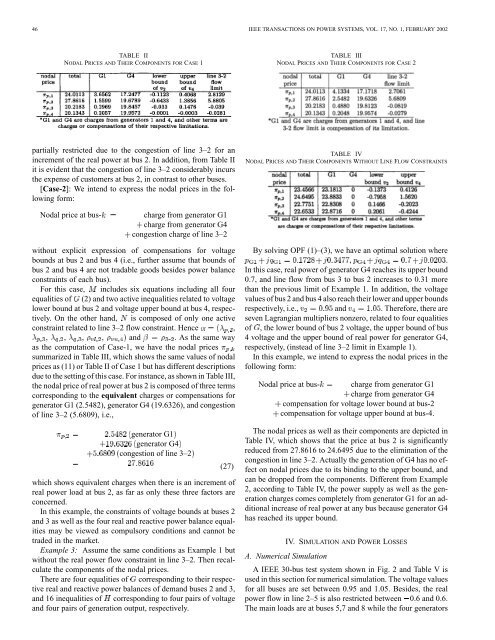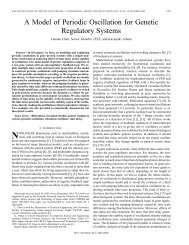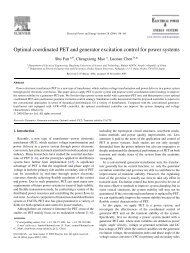Components of nodal prices for electric power systems - Power ...
Components of nodal prices for electric power systems - Power ...
Components of nodal prices for electric power systems - Power ...
Create successful ePaper yourself
Turn your PDF publications into a flip-book with our unique Google optimized e-Paper software.
46 IEEE TRANSACTIONS ON POWER SYSTEMS, VOL. 17, NO. 1, FEBRUARY 2002TABLE IINODAL PRICES AND THEIR COMPONENTS FOR CASE 1TABLE IIINODAL PRICES AND THEIR COMPONENTS FOR CASE 2partially restricted due to the congestion <strong>of</strong> line 3–2 <strong>for</strong> anincrement <strong>of</strong> the real <strong>power</strong> at bus 2. In addition, from Table IIit is evident that the congestion <strong>of</strong> line 3–2 considerably incursthe expense <strong>of</strong> customers at bus 2, in contrast to other buses.[Case-2]: We intend to express the <strong>nodal</strong> <strong>prices</strong> in the following<strong>for</strong>m:TABLE IVNODAL PRICES AND THEIR COMPONENTS WITHOUT LINE FLOW CONSTRAINTSNodal price at bus-charge from generator G1charge from generator G4congestion charge <strong>of</strong> line 3–2without explicit expression <strong>of</strong> compensations <strong>for</strong> voltagebounds at bus 2 and bus 4 (i.e., further assume that bounds <strong>of</strong>bus 2 and bus 4 are not tradable goods besides <strong>power</strong> balanceconstraints <strong>of</strong> each bus).For this case, includes six equations including all fourequalities <strong>of</strong> (2) and two active inequalities related to voltagelower bound at bus 2 and voltage upper bound at bus 4, respectively.On the other hand, is composed <strong>of</strong> only one activeconstraint related to line 3–2 flow constraint. Hence ,, , and - . As the same wayas the computation <strong>of</strong> Case-1, we have the <strong>nodal</strong> <strong>prices</strong>summarized in Table III, which shows the same values <strong>of</strong> <strong>nodal</strong><strong>prices</strong> as (11) or Table II <strong>of</strong> Case 1 but has different descriptionsdue to the setting <strong>of</strong> this case. For instance, as shown in Table III,the <strong>nodal</strong> price <strong>of</strong> real <strong>power</strong> at bus 2 is composed <strong>of</strong> three termscorresponding to the equivalent charges or compensations <strong>for</strong>generator G1 (2.5482), generator G4 (19.6326), and congestion<strong>of</strong> line 3–2 (5.6809), i.e.,generator G1generator G4congestion <strong>of</strong> line 3–2(27)which shows equivalent charges when there is an increment <strong>of</strong>real <strong>power</strong> load at bus 2, as far as only these three factors areconcerned.In this example, the constraints <strong>of</strong> voltage bounds at buses 2and 3 as well as the four real and reactive <strong>power</strong> balance equalitiesmay be viewed as compulsory conditions and cannot betraded in the market.Example 3: Assume the same conditions as Example 1 butwithout the real <strong>power</strong> flow constraint in line 3–2. Then recalculatethe components <strong>of</strong> the <strong>nodal</strong> <strong>prices</strong>.There are four equalities <strong>of</strong> corresponding to their respectivereal and reactive <strong>power</strong> balances <strong>of</strong> demand buses 2 and 3,and 16 inequalities <strong>of</strong> corresponding to four pairs <strong>of</strong> voltageand four pairs <strong>of</strong> generation output, respectively.By solving OPF (1)–(3), we have an optimal solution where, .In this case, real <strong>power</strong> <strong>of</strong> generator G4 reaches its upper bound0.7, and line flow from bus 3 to bus 2 increases to 0.31 morethan the previous limit <strong>of</strong> Example 1. In addition, the voltagevalues <strong>of</strong> bus 2 and bus 4 also reach their lower and upper boundsrespectively, i.e., and . There<strong>for</strong>e, there areseven Lagrangian multipliers nonzero, related to four equalities<strong>of</strong> , the lower bound <strong>of</strong> bus 2 voltage, the upper bound <strong>of</strong> bus4 voltage and the upper bound <strong>of</strong> real <strong>power</strong> <strong>for</strong> generator G4,respectively, (instead <strong>of</strong> line 3–2 limit in Example 1).In this example, we intend to express the <strong>nodal</strong> <strong>prices</strong> in thefollowing <strong>for</strong>m:Nodal price at bus- charge from generator G1charge from generator G4compensation <strong>for</strong> voltage lower bound at bus-2compensation <strong>for</strong> voltage upper bound at bus-4.The <strong>nodal</strong> <strong>prices</strong> as well as their components are depicted inTable IV, which shows that the price at bus 2 is significantlyreduced from 27.8616 to 24.6495 due to the elimination <strong>of</strong> thecongestion in line 3–2. Actually the generation <strong>of</strong> G4 has no effecton <strong>nodal</strong> <strong>prices</strong> due to its binding to the upper bound, andcan be dropped from the components. Different from Example2, according to Table IV, the <strong>power</strong> supply as well as the generationcharges comes completely from generator G1 <strong>for</strong> an additionalincrease <strong>of</strong> real <strong>power</strong> at any bus because generator G4has reached its upper bound.IV. SIMULATION AND POWER LOSSESA. Numerical SimulationA IEEE 30-bus test system shown in Fig. 2 and Table V isused in this section <strong>for</strong> numerical simulation. The voltage values<strong>for</strong> all buses are set between 0.95 and 1.05. Besides, the real<strong>power</strong> flow in line 2–5 is also restricted between 0.6 and 0.6.The main loads are at buses 5,7 and 8 while the four generators






